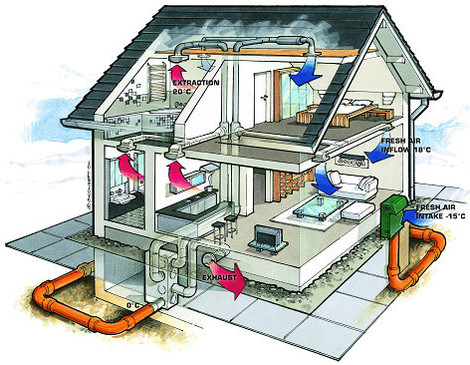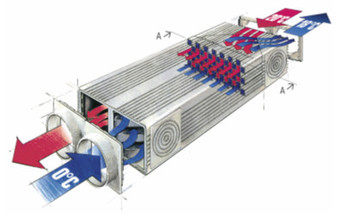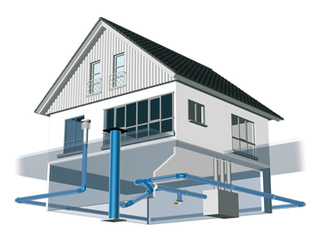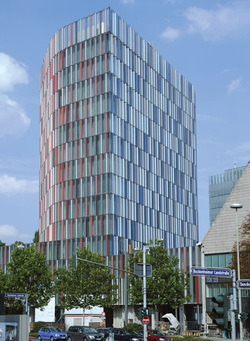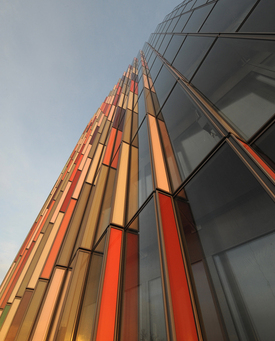PAUL COMFORT VENTILATION
PAUL Comfort Ventilation is a leader in the field of mechanical ventilation heat recovery (MVHR). Established in 1994, PAUL has pioneered the development of highly efficient, very quiet, domestic heat recovery units.
Combining their patented channel counter flow heater exchangers with the very latest in low energy dc silent fan technology means that PAUL units achieve the very highest standards.
ADVANTAGES:
Combining their patented channel counter flow heater exchangers with the very latest in low energy dc silent fan technology means that PAUL units achieve the very highest standards.
ADVANTAGES:
- Real energy savings
- Lower heating bills
- Constant fresh air
- Low pollen levels
- Reduced humidity
- Quieter living
- Cooling in summer
- Constant odour & dust mite removal
- No mildew or mould
THE HEAT EXCHANGER: The heart of every PAUL Comfort Ventilation system is the heat exchanger. This is where the heat from the outgoing air is transferred to the incoming air. This works both ways so if the outside temperature is higher than inside the exchanger helps to maintain a constant pleasant internal climate.
DESIGNED TO BE INAUDIBLE: The high quality balanced fans and attention to detail make PAUL units the quietest on the market. There is no point in building a low energy house if people don't want to live in it.
AIR QUALITY: Paul Comfort Ventilation uses high quality large surface area filters that ensure a clean air supply. The large surface area of the filters provides an extended service interval and reduces loss of flow. A properly tuned comfort ventilation system prevents CO2 build up with out the need to open windows. Removing the need to open windows has the added benefit of keeping the noise of modern day life out side of the home.
DESIGNED TO BE INAUDIBLE: The high quality balanced fans and attention to detail make PAUL units the quietest on the market. There is no point in building a low energy house if people don't want to live in it.
AIR QUALITY: Paul Comfort Ventilation uses high quality large surface area filters that ensure a clean air supply. The large surface area of the filters provides an extended service interval and reduces loss of flow. A properly tuned comfort ventilation system prevents CO2 build up with out the need to open windows. Removing the need to open windows has the added benefit of keeping the noise of modern day life out side of the home.
PRODUCT RANGE: PAUL Comfort Ventilation units can be fitted in suspended ceilings, horizontally in boxing over kitchen cupboards, vertically in a larder unit, or a utility room or garage. They can supply ventilation demands from 30 to 6000m³/h. The compact units consume air source heat pump technology to provide both heat and hot water along side the ventilation requirement.
AWADUKT THERMO VENTILATION: The ground-air heat exchanger AWADUKT Thermo exploits the energy stored in the ground. By drawing air through an underground network of pipes, it provides a source of heating in the winter and cooling in the summer. In combination with heat recovery devices, it is possible to can save not only money and energy with the free zero carbon energy, but also improve the air quality in their building significantly.
AWADUKT THERMO VENTILATION: The ground-air heat exchanger AWADUKT Thermo exploits the energy stored in the ground. By drawing air through an underground network of pipes, it provides a source of heating in the winter and cooling in the summer. In combination with heat recovery devices, it is possible to can save not only money and energy with the free zero carbon energy, but also improve the air quality in their building significantly.
BENEFITS:
- Reduction of heating costs by pre-heating air in winter.
- Pleasant cooling effect in summer reduces need for air-conditioning.
- Improvement of the air quality in the building through dust and pollen filters.
- No build up of microbes inside the pipe system due to silver pipe lining.
- Improved heat conductivity of pipes to ensure optimal heat transfer.
- Individual designs checked with REHAU software, factoring location, soil and use.
- Infinite pipe layouts available.
- Radon proof joints.
- Well ventilated house which can stay cool in summer and warm in winter.
EXAMPLE: WESTARKADE TOWER
FRANKFURT, GERMANY
This naturally ventilated skyscraper is believed to be a world leader in energy efficient buildings. Architect Perepelitza claims the 15 storey green construction could point the way forward for glass towers, this building represents a new generation.
Natural ventilation will be provided by 180 vertical flaps in the outer layers, allowing for control of the air flow and creating a pressure-ring façade. Control systems will monitor the weather and internal environment of the tower, opening and closing the natural ventilation system to maintain an optimum indoor climate at all times.
Passive ventilation should be sufficient during spring and autumn to eliminate the need for electro-mechanical systems altogether, significantly cutting down on the building's carbon footprint.
London's famous Gherkin building uses a similar natural ventilation system and was awarded the Stirling Prize from the Royal Institute of British Architects in October 2004, recognising the city's first environmental skyscraper.
FRANKFURT, GERMANY
This naturally ventilated skyscraper is believed to be a world leader in energy efficient buildings. Architect Perepelitza claims the 15 storey green construction could point the way forward for glass towers, this building represents a new generation.
Natural ventilation will be provided by 180 vertical flaps in the outer layers, allowing for control of the air flow and creating a pressure-ring façade. Control systems will monitor the weather and internal environment of the tower, opening and closing the natural ventilation system to maintain an optimum indoor climate at all times.
Passive ventilation should be sufficient during spring and autumn to eliminate the need for electro-mechanical systems altogether, significantly cutting down on the building's carbon footprint.
London's famous Gherkin building uses a similar natural ventilation system and was awarded the Stirling Prize from the Royal Institute of British Architects in October 2004, recognising the city's first environmental skyscraper.
